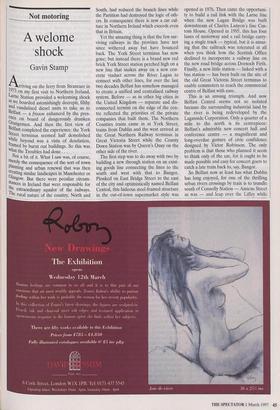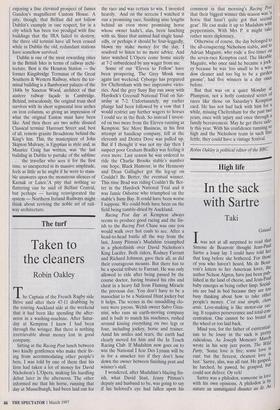Not motoring
A welome
shock
Gavin Stamp
Arriving on the ferry from Stranraer in 1973 on my first visit to Northern Ireland, Larne Station provided a welcoming shock as we boarded astonishingly decrepit, filthy and vandalised diesel units to take us to Belfast — a frisson enhanced by the pres- ence on board of dangerously drunken Orangemen. And then the first view of Belfast completed the experience: the York Street terminus seemed half demolished '41, hde beyond was a vista of desolation, 'tamed by burnt out buildings. So this was what the Troubles had done . . . Not a bit of it. What I saw was, of course, merely the consequence of the sort of town planning and urban renewal that was then creating similar landscapes in Manchester or Glasgow. But there were peculiar circum- stances in Ireland that were responsible for the extraordinary squalor of the railways. The rural nature of the country, North and South, had reduced the branch lines while the Partition had destroyed the logic of oth- ers. In consequence there is now a car cul- ture in Northern Ireland which exceeds even that in Britain.
Yet the amazing thing is that the few sur- viving railways in the province have not since withered away but have bounced back. The York Street terminus has now gone; but instead there is a brand new red brick York Street station perched high on a new line that snakes away on a new con- crete viaduct across the River Lagan to connect with other lines, for over the last two decades Belfast has somehow managed to create a unified and centralised railway system. Before — as in other big cities in the United Kingdom — separate and dis- connected termini on the edge of the cen- tre reflected the priorities of the private companies that built them. The Northern Counties trains came in at York Street; trains from Dublin and the west arrived at the Great Northern Railway terminus in Great Victoria Street while the County Down Station was by Queen's Quay on the other side of the river.
The first step was to do away with two by building a new through station on an exist- ing goods line connecting the lines to the south and west with that to Bangor. Plonked on East Bridge Street to the east of the city and optimistically named Belfast Central, this hideous steel-framed structure in the out-of-town supermarket style was opened in 1976. Then came the opportuni- ty to build a rail link with the Lame line when the new Lagan Bridge was built downstream of Charles Lanyon's fine Cus- tom House. Opened in 1995, this has four lanes of motorway and a rail bridge carry- ing a single track — typical, but it is amaz- ing that the railtrack was tolerated at all when you think how the Scottish Office declined to incorporate a railway line on the new road bridge across Dornoch Firth. Finally, a new little station — linked with a bus station — has been built on the site of the old Great Victoria Street terminus to enable commuters to reach the commercial centre of Belfast with ease.
This is an unsung triumph. And now Belfast Central seems not so isolated because the surrounding industrial land by the river is being redeveloped by the Laganside Corporation. Only a quarter of a mile to the north is its centrepiece: Belfast's admirable new concert hall and conference centre — a magnificent and long-overdue gesture of civic confidence designed by Victor Robinson. The only problem is that those who planned it seem to think only of the car, for it ought to be made possible and easy for concert goers to catch a late train back to, say, Bangor.
So Belfast now at least has what Dublin has long enjoyed, for one of the thrilling urban rivers crossings by train is to trundle south of Connolly Station — Amiens Street as was — and leap over the Liffey while enjoying a fine elevated prospect of James Gandon's magnificent Custom House. A pity, though, that Belfast did not follow Dublin's example in one respect, for in a city which has been too prodigal with fine buildings that the IRA failed to destroy, the three old termini have all been erased while in Dublin the old, redundant stations have somehow survived.
Dublin is one of the most rewarding cities in the British Isles in terms of railway archi- tecture. Best is the Heuston Station — the former Kingsbridge Terminus of the Great Southern & Western Railway, where the ter- minal building is a flamboyant palazzo of the 1840s by Sancton Wood, architect of that austere railway façade in Cambridge. Behind, miraculously, the original train shed survives with its short segmental iron arches on iron columns, so giving an impression of what the original Euston must have been like. And then there are two noble disused Classical termini: Harcourt Street and, best of all, remote granite Broadstone behind the King's Inn. This, the masterpiece of John Skipton Mulvany, is Egyptian in style and, as Maurice Craig has written, was 'the last building in Dublin to partake of the sublime . . . the traveller who sees it for the first time, so unexpected in its massive amplitude, feels as little as he might if he were to stum- ble unawares upon the monstrous silences of Karnak or Luxor.'A pity that nothing so flattering can be said of Belfast Central, but perhaps — having reinvigorated the system — Northern Ireland Railways might think about reviving the noble art of rail- way architecture.



























































 Previous page
Previous page